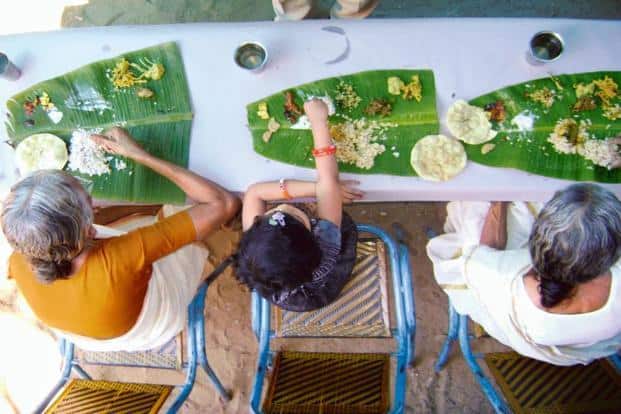I loved this week’s issue of Mint Lounge. Sumant Jaikrishnan is an authentic Indian stylister (the male version of stylista). I loved the cover. Read it here.
My piece is on Pappadams. Nice accompanying photo. Read it here and below.
Sat, Jul 27 2013. 12 07 AM IST
Pondering over ‘poppadoms’
Poppadoms are more fluff than substance. They are glorious, ephemeral and gone in minutes

Papad or as south Indians call it, poppadom, is a popular part of Indian meals across regions. Photo: Manoj Madhavan/Mint
The essential dishes of a Kerala sadya (feast) are paruppu (dal/lentils), pachadi (raita), and payasam (kheer). To that, I would add the poppadom or papad. This triumvirate reflects Indian vegetarian cuisine across most regions. There is the dal for protein, the yogurt-based raita to cool off and provide calcium, there is the sweet dish ranging from shrikhand to sandesh to kheer or payasam, and there is papad, which is our version of chips.
The south Indian paruppu is nondescript. Imagine yellow dal, cooked with salt. That’s it. Kerala payasam is to die for and deserves a separate column. As for the poppadom, they are the high-calorie version of the Lijjat papad that has now become synonymous with women’s empowerment and self-help groups.
There are two kinds of papads in south India. There is the traditional appalam, which is made from urad dal and stays flat when fried. It may expand in circumference but not in volume. The poppadom has a bit of soda and therefore puffs up like a bhatura when fried. My Rajasthani friends eat a papad at the end of the meal. The dry papad, they say, will soak up all the desi ghee that the rest of their dishes are made from: a kind of sponge-effect all through the alimentary canal, with the papad doing what statin drugs do for cholesterol. I don’t buy this theory. I can understand the papad soaking up the desi ghee, but where does the papad then dump the desi ghee? That is unclear.
Poppadoms are famous all over Kerala. My village in Palakkad has many homes that make and sell poppadoms. The women mix the black gram flour with salt, pepper and a little baking soda; roll it out and dry it in the sun. They look a whole lot better than appalams when fried. My husband will only eat appalams because they are flat and unsullied by baking soda. His purist, unforgiving approach is the root of many of our marital quarrels. I go for show; he goes for substance, he says. I go for quirkiness; he goes for predictability, I say.
When you fry a poppadom, you never know how it will turn out. Some will puff out beautifully like a puri but most will do their own dance. Half of the poppadom will puff and the other will remain flat. It is a quirky dish. All appalams, on the other hand, will fry out flat. No rising or falling for them. In that sense, poppadoms, not to put too fine a point on it, are like life. Or so I tell my husband.
Years ago, one of my cousins married a Gujarati. At their wedding in Vadodra, the elders in my family were exposed to masala papads for the first time. Once they got over their fear of raw onions, they began devouring the stuff.
A TamBrahm boy marrying a Gujarati “Shah” girl: Now, there’s a menu discussion. The first thing that the mother of the boy—my cousin—did was forbid “the sweet stuff” in savoury dishes. Anjali’s mother countered by saying that their family was allergic to the shredded coconut that was freely thrown around in our dishes. Finally, the families did the only thing possible. We cleaved the feasts. Anjali’s side got the reception dinner, and for us children, it was a wonderland. We entered to find stalls and counters serving delicacies that we had never encountered all through our doused-in-coconut-oil childhood. There was chaat and what appeared to be giant frisbees that were borne aloft by waiters. These frisbees were masala papads and after a bit of sniffing, even the elders loved them. In exchange, we introduced the Gujaratis to poppadom; and are forever couriering them to relatives in Ahmedabad, Vadodara and Surat.
Whether it is Mexican nachos, American potato chips or Indian papads, cultures love crunchiness, it seems. They provide a brittle counterpoint to the softness of cooked food. They taste good; witness numerous cranky toddlers who will not touch anything on a banana leaf save the poppadom. It is not merely because they are deep-fried although that helps. It is that they don’t make culinary demands on our palate. Papads aren’t complex foods that you eat because you must. They don’t require you to process multiple textures like in a salad. They lack the girth of meats. The first sign of culinary ageing is when you eschew chips or papads. It is one short step to mashed-up goop after that.
Like bubbles or balloons or cotton candy—all of which are adored by children—poppadoms are more fluff than substance. They are glorious, ephemeral and gone in minutes.
Shoba Narayan loves masala papad, but she will take puffed-up poppadom any day.




Payasam is Payasam…!! Kheer is an abomination in comparison… :-)
Allow people to devour a well made payasam ( especially chakka prathaman – no translations, let them ignoramuses google the recipe, cook and savour it to interpret it) and go get a life…
And Pappadam goes well with payasam, boli and aamavada…and when you feel you’ve had enough, don’t refuse another bowlful…Just finger lick some maangakari and go to step 1… :-)
:). Is it a Boli made by a Badma? Or a Palthma?
Ha, ha..I’ve been just a fan of the combination… For details check out http://www.boddunan.com/articles/health-fitness/56-recipes/19173-boli-and-vermicelli-payasam-for-kerala-sadya.html
Really enjoyed this article! The way you describe poppadoms with personal stories and wit makes the whole topic feel so lively and relatable.
Thank you so much